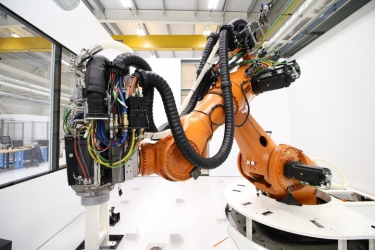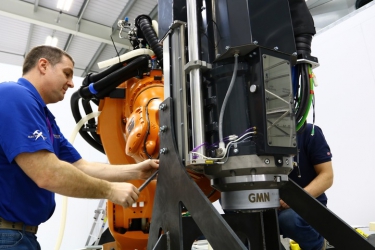In 2007 the KUKA Titan entered the Guinness Book of World Records as the largest and strongest robot in the world. A decade later a modified version of the behemoth has been given accuracy unprecedented for its size—better than 100µm (0.0039").
The customized device is the result of a $1,081,625 (£850,000) project to give the UK aerospace sector a unique capability for high accuracy robotic machining.
The Flexible Robotic Machining in High Accuracy Applications project was launched by the University of Sheffield Advanced Manufacturing Research Centre (AMRC) with Boeing, with backing from the UK’s Aerospace Technology Initiative (ATI) to develop an Accurate Robotic Milling System. The goal: “Create the most accurate large-volume machining robot in the world,” said Ben Morgan, who heads the AMRC’s Integrated Manufacturing Group at Factory 2050.
The AMRC identified the need for the project after carrying out three years of robot machining research for aerospace original equipment manufacturers (OEMs) and high-end automotive manufacturers.
AMRC started with a KUKA Titan that can carry a payload of more than 750kg (1653 lb) and with a reach of more than 3202mm (10.5'). The team incorporated highly accurate Renishaw rotary encoders into its joints and linked them to its Siemens 840D controller.
The approach was developed by aerospace automation specialist Electroimpact, Mukilteo, Wash., which has experience in creating accurate robots and has sold systems for drilling in aerospace.
The project has the potential to develop accurate and stiff robotic machining for both metallic and composite structures, offering manufacturers increased flexibility and greater efficiency, when it comes to producing higher quality components, according to Morgan.
If the modified Titan becomes the forerunner of a new generation of high-volume, high-accuracy robotic machining, it would reduce the need for expensive specialized multi-axis machine tools in aerospace and other industries.
“We believe there is great potential to achieve a step change in high accuracy robotic machining on the back of our previous research and our understanding of the fundamental mechanics,” Morgan said.
More information is at the AMRC Web site.

Related Glossary Terms
- backing
backing
1. Flexible portion of a bandsaw blade. 2. Support material behind the cutting edge of a tool. 3. Base material for coated abrasives.
- gang cutting ( milling)
gang cutting ( milling)
Machining with several cutters mounted on a single arbor, generally for simultaneous cutting.
- milling
milling
Machining operation in which metal or other material is removed by applying power to a rotating cutter. In vertical milling, the cutting tool is mounted vertically on the spindle. In horizontal milling, the cutting tool is mounted horizontally, either directly on the spindle or on an arbor. Horizontal milling is further broken down into conventional milling, where the cutter rotates opposite the direction of feed, or “up” into the workpiece; and climb milling, where the cutter rotates in the direction of feed, or “down” into the workpiece. Milling operations include plane or surface milling, endmilling, facemilling, angle milling, form milling and profiling.
- payload ( workload)
payload ( workload)
Maximum load that the robot can handle safely.
- web
web
On a rotating tool, the portion of the tool body that joins the lands. Web is thicker at the shank end, relative to the point end, providing maximum torsional strength.

